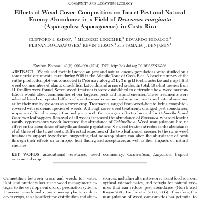Resumen
-
Weeds and their influence on pest and natural enemy populations were studied on a commercial ornamental farm during 2009 in the Atlantic Zone of Costa Rica. A baseline survey of the entire production plot was conducted in February, along a 5 by 5 m grid to characterize and map initial weed communities of plants, cicadellids, katydids, and armored scales. In total, 50 plant species from 21 families were found. Seven weed treatments were established to determine how weed manipulations would affect communities of our targeted pests and natural enemies. These treatments were selected based on reported effects of specific weed cover on herbivorous insects and natural enemies, or by their use by growers as a cover crop. Treatments ranged from weed-free to being completely covered with endemic species of weeds. Although some weed treatments changed pest abundances, responses differed among arthropod pests, with the strongest effects observed for Caldwelliola and Empoasca leafhoppers. Removal of all weeds increased the abundance of Empoasca, whereas leaving mostly cyperacaeous weeds increased the abundance of Caldwelliola. Weed manipulations had no effect on the abundance of katydid and scale populations. No weed treatment reduced the abundance of all three of the target pests. Differential responses of the two leafhopper species to the same weed treatments support hypotheses, suggesting that noncrop plants can alter the abundance of pests through their effects on arthropod host finding and acceptance, as well as their impacts on natural enemies.
